热门标签
热门文章
- 1嘉立创提示外形不完整_嘉立创识别不出板子外形
- 2【Python】Pydantic:快速上手
- 3被迫停更的洛雪,满血复活啦_洛雪音乐复活
- 4VS2015断点调试方法_vs2015打断点
- 5AI编程-vscode安装“通义灵码”_vscode 安装通义灵码
- 6day29 贪心算法-gasStation+candy+lemonadeChange+queueReconstruction
- 73个月业余时间,实现转型AI大模型工程师和AI产品经理_转型大模型工程师
- 8Docker 基本操作 镜像操作 -- docker镜像命令_docker运行镜像命令
- 9【亲测】SpringCloud之Eureka注册中心
- 10MATLAB初始化智能算法编码-产生随机不重复整数序列矩阵_matlab矩阵不重复随机生成
当前位置: article > 正文
图像增强方法汇总OpenCV+python实现【第一部分:常用图像增强方法】_图像增强的方法有哪些
作者:weixin_40725706 | 2024-08-20 20:11:29
赞
踩
图像增强的方法有哪些
前言
图像增强是指通过各种技术手段改善图像的视觉效果,使其更适合特定的应用场景。以下是一些常见的图像增强方法。
注意:本文从广义的角度讲图像增强方法,这些图像增强方法不一定都适用于CV中AI模型训练前的图像处理
常用的图像增强方法
在CV模型的训练过程中,图像增强(Image Augmentation)是一个非常重要的技术,可以有效地增加训练数据的多样性,防止过拟合,并提高模型的泛化能力。以下是一些常用的图像增强方法,它们在训练CNN模型时非常有用:
1. 旋转(Rotation):
- 随机旋转图像一定角度。
# 图像路径,替换成你的图片路径 image_path = '1.jpg' # 载入图像 image = cv2.imread(image_path) # 获取图像尺寸 (h, w) = image.shape[:2] # 设置旋转的中心为图像中心 center = (w / 2, h / 2) # 生成一个-90到90之间的随机旋转角度 angle = np.random.uniform(-90, 90) # 获取旋转矩阵,其中1.0表示图像旋转后不改变大小 rotation_matrix = cv2.getRotationMatrix2D(center, angle, 1.0) # 执行旋转操作 rotated_image = cv2.warpAffine(image, rotation_matrix, (w, h)) # 显示原图和旋转后的图像 cv2.imshow('Original Image', image) cv2.imshow('Rotated Image', rotated_image) # 按任意键退出 cv2.waitKey(0) cv2.destroyAllWindows()
- 1
- 2
- 3
- 4
- 5
- 6
- 7
- 8
- 9
- 10
- 11
- 12
- 13
- 14
- 15
- 16
- 17
- 18
- 19
- 20
- 21
- 22
- 23
- 24
- 25
- 26
- 27
- 28
- 29
- 30
旋转效果如下:

2. 平移(Translation):
- 随机平移图像在水平或垂直方向上的位置。
# 获取图像的高和宽 height, width = image.shape[:2] # 随机生成平移量(注意:这里需要确保平移量不会使图像超出边界) tx = np.random.randint(-100, 100) # 水平方向上的平移量,单位:像素 ty = np.random.randint(-100, 100) # 垂直方向上的平移量,单位:像素 # 确保平移后的图像不会超出原始图像的边界 tx = max(min(tx, width-1), 0) ty = max(min(ty, height-1), 0) # 创建仿射变换矩阵 translation_matrix = np.float32([[1, 0, tx], [0, 1, ty]]) # 应用仿射变换 translated_image = cv2.warpAffine(image, translation_matrix, (width, height)) # 显示或保存平移后的图像 cv2.imshow('Original Image', image) cv2.imshow('Translated Image', translated_image) cv2.waitKey(0) cv2.destroyAllWindows()
- 1
- 2
- 3
- 4
- 5
- 6
- 7
- 8
- 9
- 10
- 11
- 12
- 13
- 14
- 15
- 16
- 17
- 18
- 19
- 20
- 21
- 22
- 23
- 24
平移效果如下:
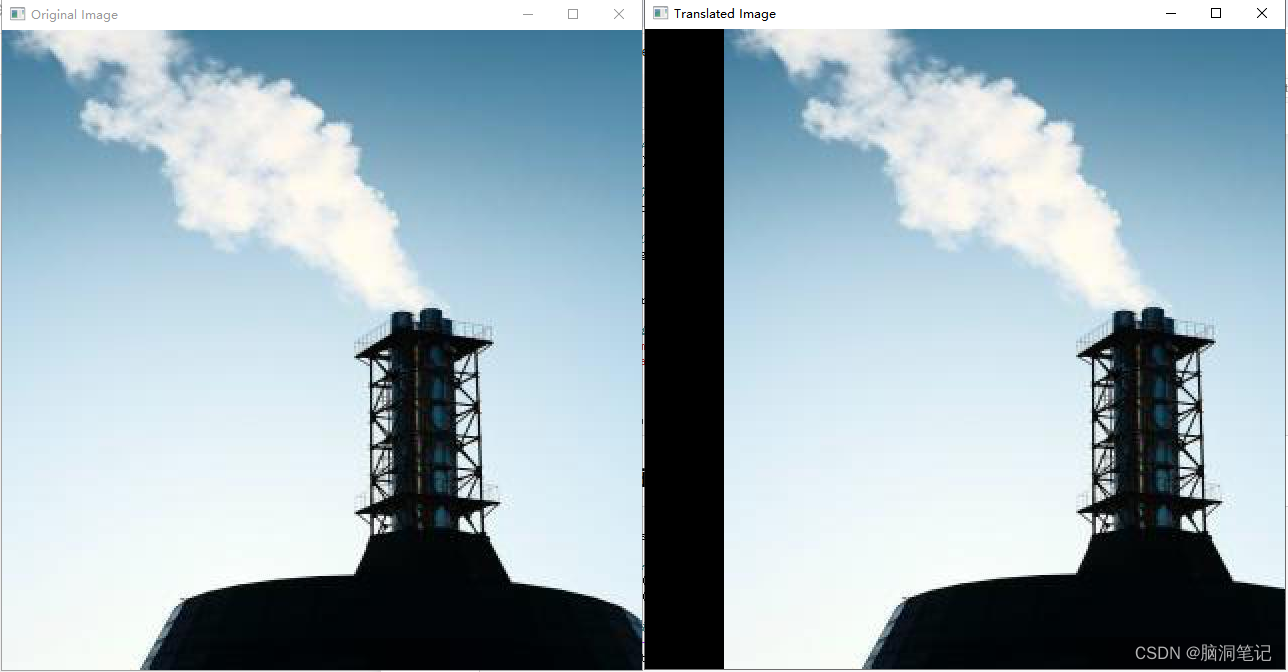
3. 缩放(Scaling):
- 随机缩放图像大小。
def random_scale_image(image, scale_range=(0.5, 1.5)): """ 随机缩放图像的大小。 :param image: 要缩放的图像,应为numpy数组形式 :param scale_range: 缩放比例的范围,默认(0.5, 1.5),即缩放后的大小在原始大小的50%到150%之间 :return: 缩放后的图像 """ # 生成一个随机的缩放比例 scale = np.random.uniform(scale_range[0], scale_range[1]) # 获取原始图像的高度和宽度 height, width = image.shape[:2] # 计算缩放后的新高度和宽度 new_height = int(height * scale) new_width = int(width * scale) # 使用cv2.resize()进行缩放 scaled_image = cv2.resize(image, (new_width, new_height), interpolation=cv2.INTER_LINEAR) return scaled_image # 随机缩放图像 scaled_image = random_scale_image(image) # 显示缩放后的图像(如果需要) cv2.imshow('Original Image', image) cv2.imshow('Scaled Image', scaled_image) cv2.waitKey(0) cv2.destroyAllWindows()
- 1
- 2
- 3
- 4
- 5
- 6
- 7
- 8
- 9
- 10
- 11
- 12
- 13
- 14
- 15
- 16
- 17
- 18
- 19
- 20
- 21
- 22
- 23
- 24
- 25
- 26
- 27
- 28
- 29
- 30
- 31
- 32
- 33
缩放效果:
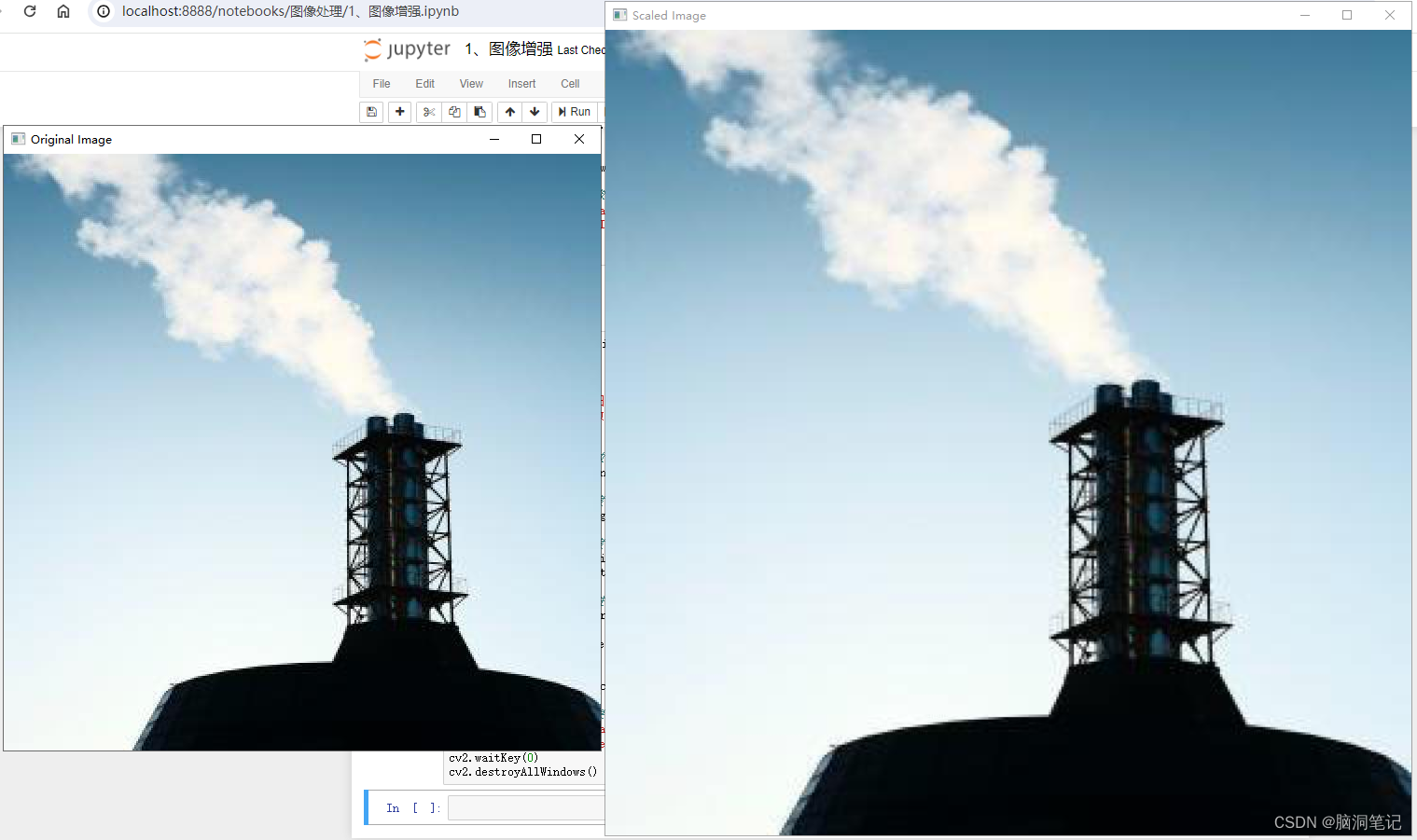
4. 剪切变换(Shear Transform):
- 随机剪切图像。
import random # 步骤1:定义随机剪切参数 # 注意:这里我们假设剪切的区域不能超出原始图像的范围 shear_height = random.randint(1, height // 2) # 随机剪切高度(这里设定为图像高度的一半以下) shear_width = random.randint(1, width // 2) # 随机剪切宽度(这里设定为图像宽度的一半以下) start_y = random.randint(0, height - shear_height) start_x = random.randint(0, width - shear_width) # 步骤2:剪切图像 sheared_image = image[start_y:start_y+shear_height, start_x:start_x+shear_width] # 步骤3:显示或保存剪切后的图像 cv2.imshow('Original Image', image) cv2.imshow('Sheared Image', sheared_image) cv2.waitKey(0) cv2.destroyAllWindows()
- 1
- 2
- 3
- 4
- 5
- 6
- 7
- 8
- 9
- 10
- 11
- 12
- 13
- 14
- 15
- 16
- 17
- 18
- 19
- 20
效果

5. 翻转(Flipping):
- 随机水平或垂直翻转图像。
# 定义一个函数来随机翻转图像 def random_flip(image): # 随机选择翻转模式 flip_code = random.choice([0, 1]) # 0为垂直翻转,1为水平翻转 # 使用cv2.flip函数进行翻转 flipped_image = cv2.flip(image, flip_code) return flipped_image # 调用函数并显示翻转后的图像 flipped_image = random_flip(image) cv2.imshow('Original Image', image) cv2.imshow('Flipped Image', flipped_image) cv2.waitKey(0) cv2.destroyAllWindows()
- 1
- 2
- 3
- 4
- 5
- 6
- 7
- 8
- 9
- 10
- 11
- 12
- 13
- 14
- 15
- 16
- 17

6. 亮度调整(Brightness Adjustment):
- 随机调整图像的亮度。
def adjust_brightness_randomly(image, alpha_range=(0.5, 1.5)): # 生成一个随机亮度调整因子 alpha = random.uniform(alpha_range[0], alpha_range[1]) # 亮度调整 adjusted_image = cv2.convertScaleAbs(image, alpha=alpha, beta=0) return adjusted_image # 随机调整亮度 adjusted_image = adjust_brightness_randomly(image) # 显示或保存调整后的图像 cv2.imshow('Original Image', image) cv2.imshow('Adjusted Image', adjusted_image) cv2.waitKey(0) cv2.destroyAllWindows()
- 1
- 2
- 3
- 4
- 5
- 6
- 7
- 8
- 9
- 10
- 11
- 12
- 13
- 14
- 15
- 16
- 17
- 18
- 19
- 20
- 21
效果
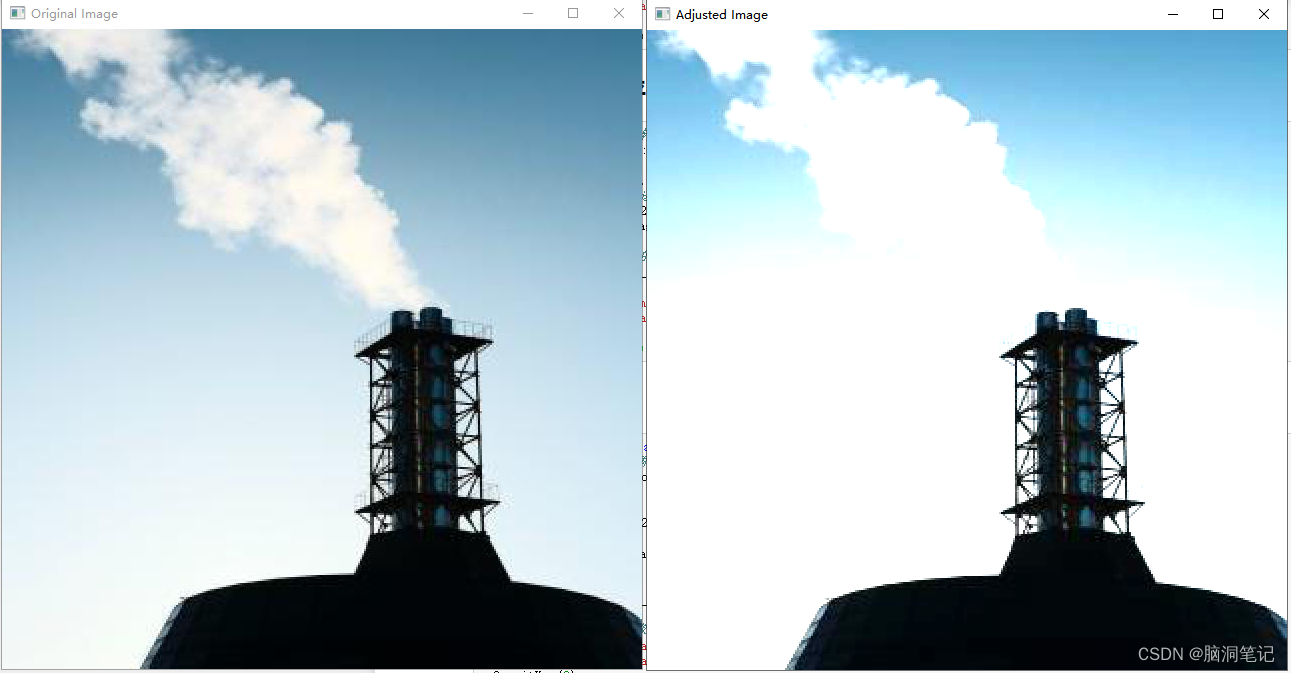
7. 对比度调整(Contrast Adjustment):
- 随机调整图像的对比度。
def random_contrast(image, contrast_range=[0.5, 1.5]): # 获取图像的维度 h, w, _ = image.shape # 随机选择对比度系数 contrast_factor = np.random.uniform(contrast_range[0], contrast_range[1]) # 创建一个空的浮点型图像来存储调整后的图像 adjusted_image = np.zeros((h, w, 3), dtype=np.float32) # 对图像进行对比度调整 for i in range(h): for j in range(w): # 将像素值归一化到0-1之间 pixel = image[i, j] / 255.0 # 调整对比度 adjusted_pixel = np.clip(contrast_factor * (pixel - 0.5) + 0.5, 0, 1) # 将像素值转换回0-255 adjusted_image[i, j] = adjusted_pixel * 255 # 将浮点数图像转换为无符号整数 adjusted_image = np.uint8(adjusted_image) return adjusted_image # 随机调整图像的对比度 adjusted_image = random_contrast(image) # 显示原始图像和调整后的图像 cv2.imshow('Original Image', image) cv2.imshow('Adjusted Image', adjusted_image) cv2.waitKey(0) cv2.destroyAllWindows()
- 1
- 2
- 3
- 4
- 5
- 6
- 7
- 8
- 9
- 10
- 11
- 12
- 13
- 14
- 15
- 16
- 17
- 18
- 19
- 20
- 21
- 22
- 23
- 24
- 25
- 26
- 27
- 28
- 29
- 30
- 31
- 32
- 33
- 34
- 35
- 36
- 37
效果如下
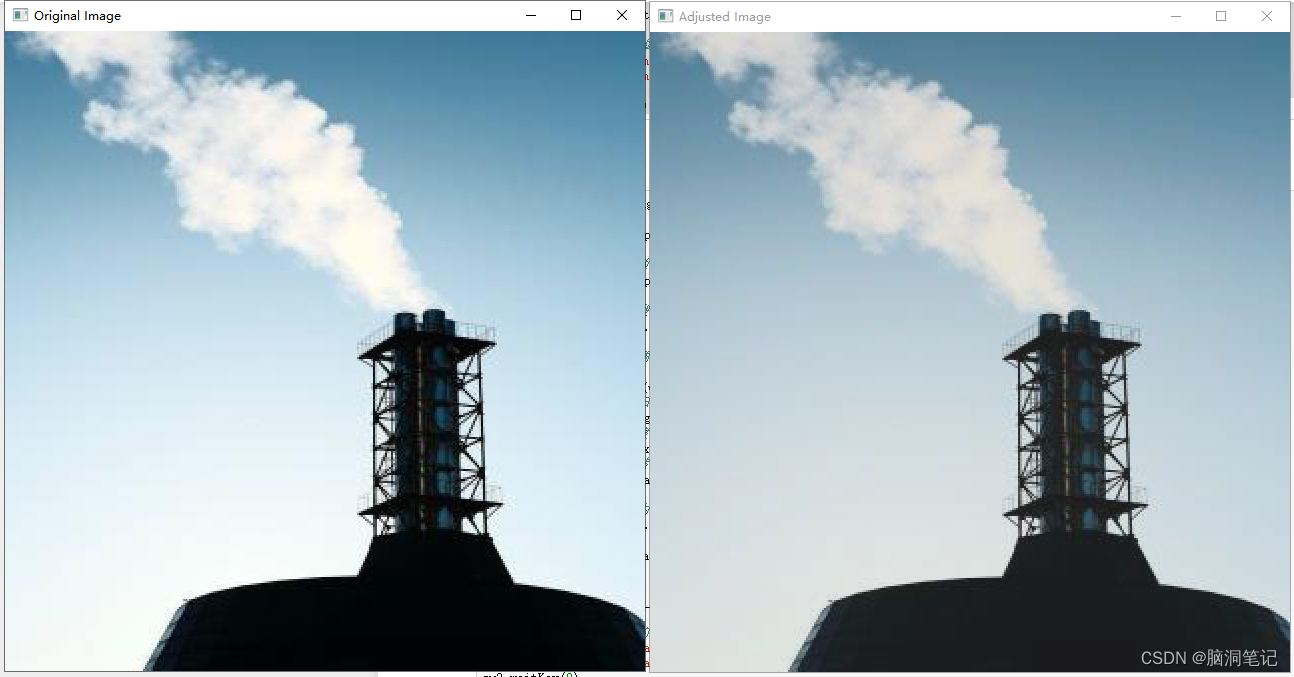
8. 添加噪声(Adding Noise):
- 随机向图像中添加噪声。
# 将图像数据转换为浮点型以支持噪声添加 image_N = image.astype(np.float32) # 定义高斯噪声的均值和标准差 mean = 0 stddev = 50.0 # 可以根据需要调整这个值来控制噪声的强度 # 生成高斯噪声 noise = np.random.normal(mean, stddev, image_N.shape) # 将噪声添加到图像上 noisy_image = np.clip(image_N + noise, 0, 255).astype(np.uint8) # 显示或保存带噪声的图像 cv2.imshow('Original Image', image) cv2.imshow('Noisy Image', noisy_image) cv2.waitKey(0) cv2.destroyAllWindows()
- 1
- 2
- 3
- 4
- 5
- 6
- 7
- 8
- 9
- 10
- 11
- 12
- 13
- 14
- 15
- 16
- 17
- 18
效果
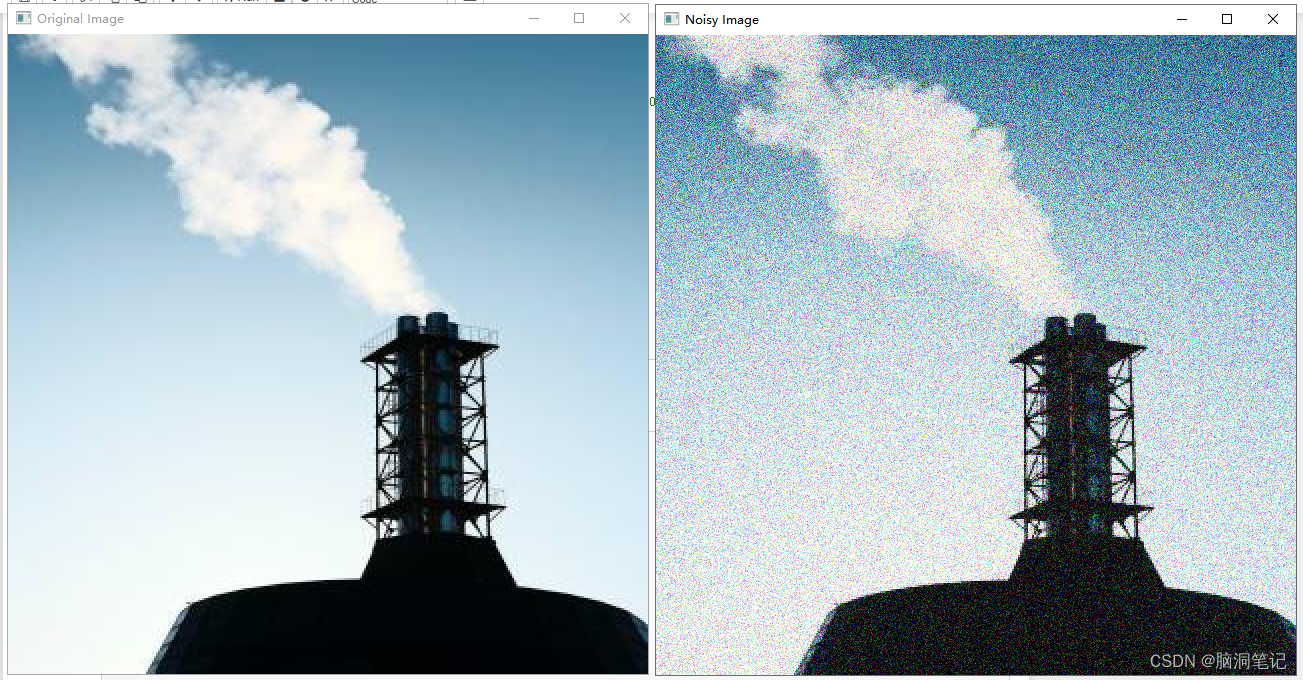
9. 颜色抖动(Color Jittering):
- 随机改变图像的颜色属性,如色调、饱和度和亮度。
def random_color_shift(image, hue_shift_range=18, sat_shift_range=30, val_shift_range=40): # 将BGR图像转换为HSV图像 hsv = cv2.cvtColor(image, cv2.COLOR_BGR2HSV) # 分解HSV图像的通道 h, s, v = cv2.split(hsv) # 随机改变色调 h = cv2.add(h, np.random.randint(-hue_shift_range, hue_shift_range+1)) h = np.clip(h, 0, 179) # 确保色调值在0-179之间 # 随机改变饱和度 s = cv2.add(s, np.random.randint(-sat_shift_range, sat_shift_range+1)) s = np.clip(s, 0, 255) # 确保饱和度值在0-255之间 # 随机改变亮度 v = cv2.add(v, np.random.randint(-val_shift_range, val_shift_range+1)) v = np.clip(v, 0, 255) # 确保亮度值在0-255之间 # 合并HSV通道 hsv_shifted = cv2.merge((h, s, v)) # 将HSV图像转换回BGR图像 image_shifted = cv2.cvtColor(hsv_shifted, cv2.COLOR_HSV2BGR) return image_shifted # 随机改变颜色属性 shifted_image = random_color_shift(image) # 显示或保存图像 cv2.imshow('Original Image', image) cv2.imshow('Shifted Image', shifted_image) cv2.waitKey(0) cv2.destroyAllWindows()
- 1
- 2
- 3
- 4
- 5
- 6
- 7
- 8
- 9
- 10
- 11
- 12
- 13
- 14
- 15
- 16
- 17
- 18
- 19
- 20
- 21
- 22
- 23
- 24
- 25
- 26
- 27
- 28
- 29
- 30
- 31
- 32
- 33
- 34
- 35
- 36
效果
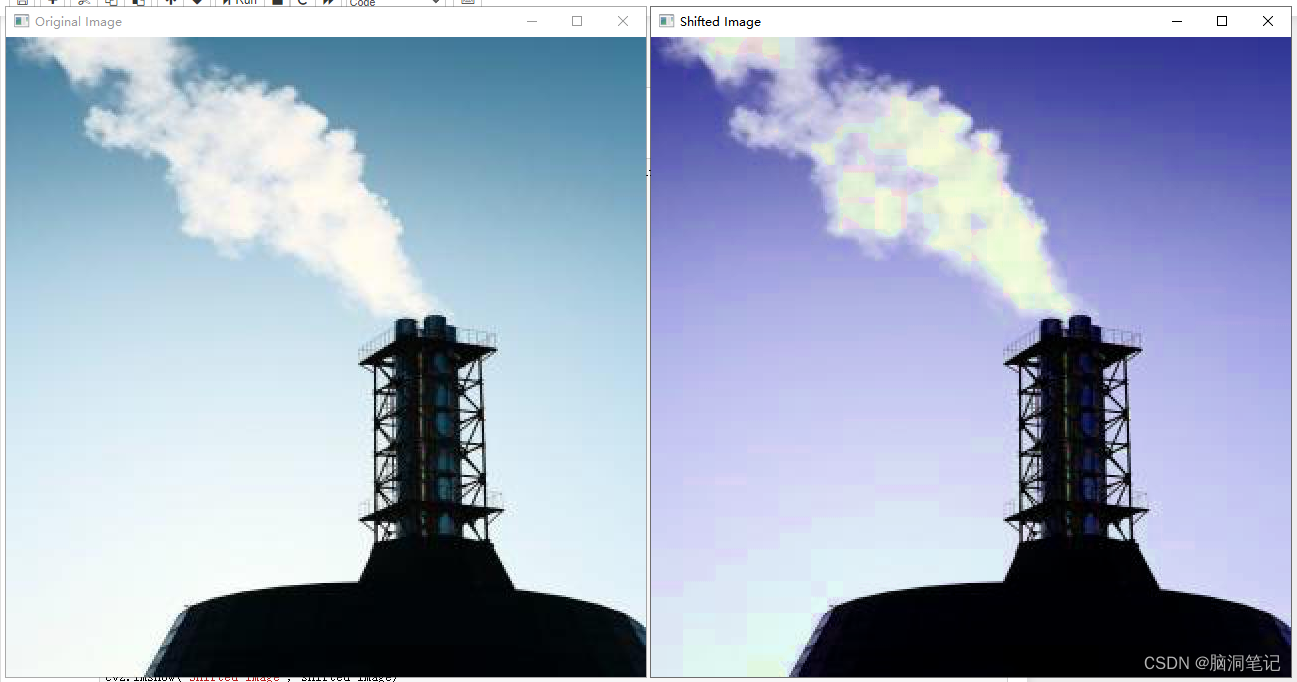
10. 随机擦除(Random Erasing)
- 随机遮挡图像的一部分,以增强模型的鲁棒性。
def random_mask_image(image, min_mask_area=0.05, max_mask_area=0.2): image_c = image.copy() height, width = image_c.shape[:2] # 确定要遮挡的面积(基于图像尺寸的百分比) min_mask_width_height = int(min(width, height) * np.sqrt(min_mask_area)) max_mask_width_height = int(min(width, height) * np.sqrt(max_mask_area)) # 随机选择遮挡区域的左上角坐标和大小 start_x = random.randint(0, width - max_mask_width_height) start_y = random.randint(0, height - max_mask_width_height) mask_width = random.randint(min_mask_width_height, max_mask_width_height) mask_height = random.randint(min_mask_width_height, max_mask_width_height) # 在图像上绘制遮挡矩形 image_c[start_y:start_y+mask_height, start_x:start_x+mask_width, :] = 0 # 使用黑色(RGB值为0,0,0)进行遮挡 return image_c # 使用示例 masked_image = random_mask_image(image) cv2.imshow('Original Image', image) cv2.imshow('Masked Image', masked_image) cv2.waitKey(0) cv2.destroyAllWindows()
- 1
- 2
- 3
- 4
- 5
- 6
- 7
- 8
- 9
- 10
- 11
- 12
- 13
- 14
- 15
- 16
- 17
- 18
- 19
- 20
- 21
- 22
- 23
- 24
- 25
- 26
效果
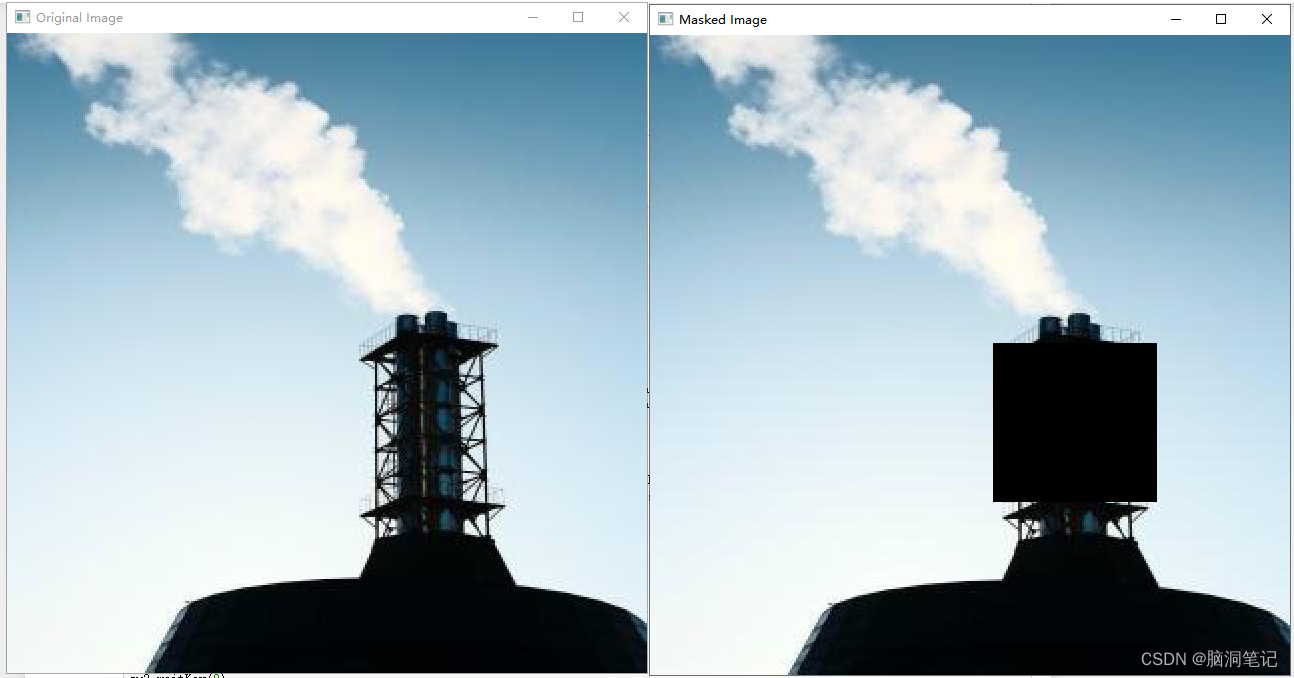
声明:本文内容由网友自发贡献,版权归原作者所有,本站不承担相应法律责任。如您发现有侵权的内容,请联系我们。转载请注明出处:【wpsshop博客】
推荐阅读
相关标签




